Jacob Jake Matijevic 1947-2012 NASA engineer of Croatian origin father of Curiosity rover on Mars
http://www.croatia.org/crown/articles/10356/1/Jacob-Jake-Matijevic-1947-2012-NASA-engineer-of-Croatian-origin-father-of-Curiosity-rover-on-Mars.html
By Nenad N. Bach and Darko ®ubrinić
Published on 12/30/2012
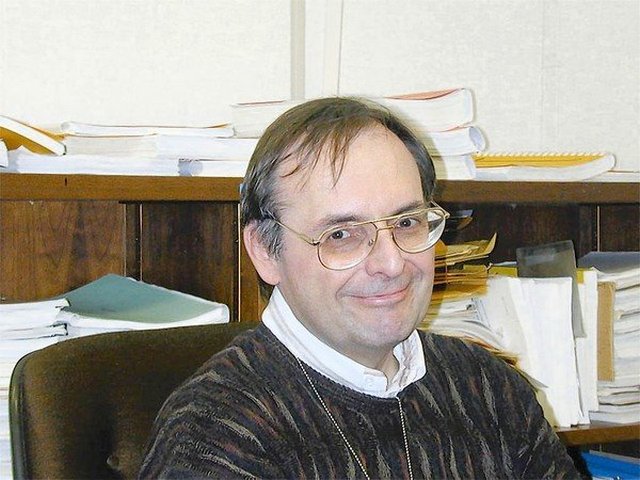
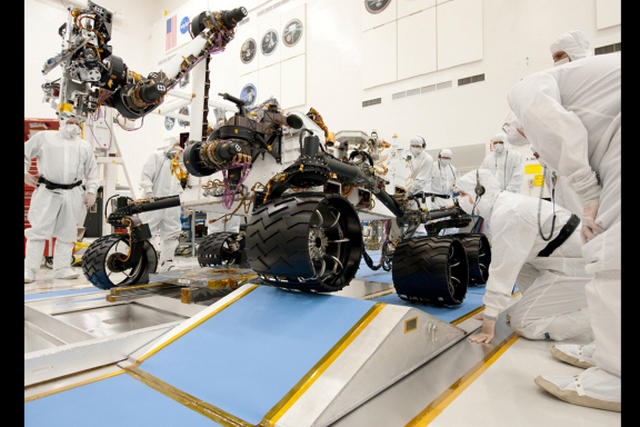
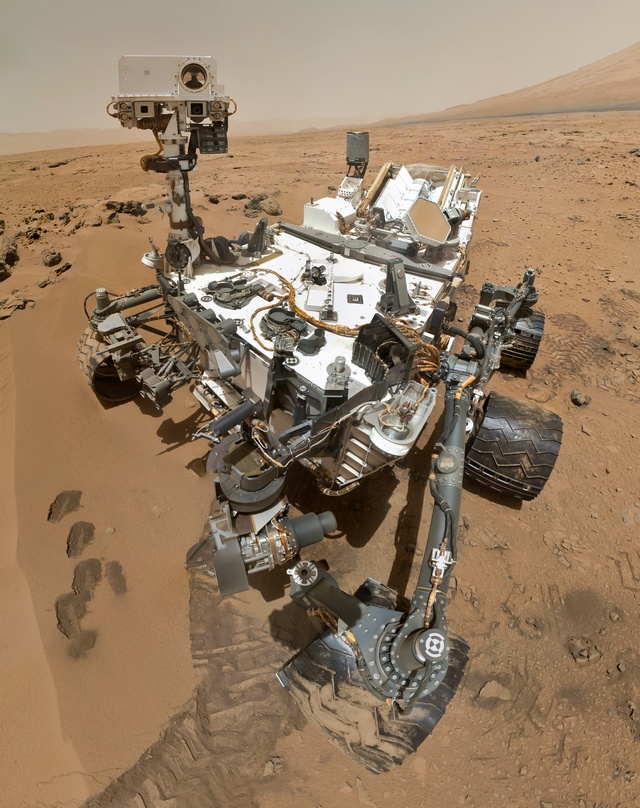
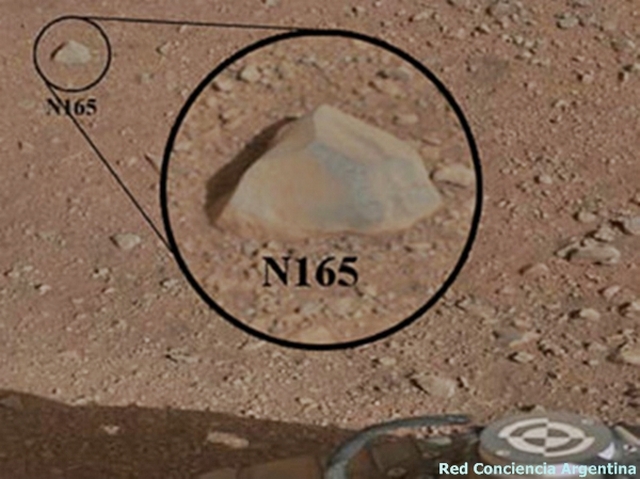

Opportunity Eyes Rock Fins on Cape York, Sol 3058
Rock fins up to about 1 foot (30 centimeters) tall dominate this scene from the panoramic camera (Pancam) on NASA's Mars Exploration Rover Opportunity.
Image Credit: NASA/JPL-Caltech/Cornell/Arizona State Univ.
 Â Â | Jacob (Richard) Matijevic, also known as "Jake" Matijevic, (3 November 1947 - 20 August 2012) was an American NASA engineer of Croatian origin who worked on Mars Exploration Rovers. Dr. Matijevic, PhD in Mathematics from the University of Chicago, was involved in developing the "Sojourner", "Spirit", "Opportunity" and "Curiosity" rovers. For his contributions to the rover projects, NASA named several landmarks (including "Matijevic Hill" and "Jake Matijevic" rock) for him on the planet Mars. |
NASA named several landmarks, including "Matijevic Hill" and "Jake Matijevic" rock, for him on the planet Mars

Jacob Matijevic, PhD in Mathematical sciences from the University of Chicago, of Croatian roots, was involved as a
leading engineer in developing the "Sojourner", "Spirit", "Opportunity" and "Curiosity" rovers for NASA.
leading engineer in developing the "Sojourner", "Spirit", "Opportunity" and "Curiosity" rovers for NASA.
Jacob Matijevic Jacob (Richard) Matijevic, also known as "Jake" Matijevic, (3 November 1947 - 20 August 2012) was an American NASA engineer of Croatian origin who worked on Mars Exploration Rovers. Dr. Matijevic was involved in developing the "Sojourner", "Spirit", "Opportunity" and "Curiosity" rovers. For his contributions to the rover projects, NASA named several landmarks (including "Matijevic Hill" and "Jake Matijevic" rock) for him on the planet Mars. Dr. Matijevic was born and grew up in Chicago, Illinois and graduated from Mount Carmel High School. In 1969, he received a bachelor's degree in mathematics from the Illinois Institute of Technology, and, in 1973, earned a Ph.D. degree in mathematics from the University of Chicago. In 1981, Dr. Matijevic began working at the Jet Propulsion Laboratory (JPL) in Pasadena, California, as a control systems engineer. In 1986, he worked in the telerobotics field and later, in 1992, began work with the Mars "Sojourner" rover. This rover was delivered to Mars by the Pathfinder spacecraft in 1996. Afterwards, Dr. Matijevic helped develop the "Spirit" and "Opportunity" rovers that began exploring Mars in 2004. He also helped develop the "Curiosity" rover that landed on Mars in August, 2012, just two weeks before his passing. After his death, NASA decided to name a Mars hill, "Matijevic Hill", encountered by the "Opportunity" rover, and also a Mars rock, "Jake Matijevic", encountered by the "Curiosity" rover, in his honor for his many contributions to the Mars rover projects over the years. Source en.wikipedia.org |


"Curiosity" of Mars
By Jet Propulsion Laboratory, Pasadena, California — Published: October 1, 2012
Image credit: NASA/JPL-Caltech/Cornell Univ./Arizona State Univ.
By Jet Propulsion Laboratory, Pasadena, California — Published: October 1, 2012
Image credit: NASA/JPL-Caltech/Cornell Univ./Arizona State Univ.
Jake Matijevic is a pyramidal rock on the surface of Aeolis Palus in Gale crater on the planet Mars The rock was named by NASA after Jacob Matijevic (1947-2012), a mathematician-turned-rover-engineer, who played a critical role in the design of the six-wheeled rover, but died just days after the Curiosity rover landed in August 2012. Matijevic was the surface operations systems chief engineer for the Mars Science Laboratory Project and the project's Curiosity rover. He was also a leading engineer for all of the previous NASA Mars rovers including Sojourner, Spirit and Opportunity. Mars rover Opportunity working at Matijevic Hill Opportunity has begun investigating the site'€™s concentration of small spherical objects reminiscent of, but different from, the iron-rich spheres nicknamed "blueberries"€ť at the rover'€™s landing site. NASA'€™s Mars rover Opportunity, well into its ninth year on Mars, will work for the next several weeks or months at a site with some of the mission's most intriguing geological features. The site, called Matijevic Hill, overlooks the 14-mile-wide (22 kilometers) Endeavour Crater. Opportunity has begun investigating the site'ss concentration of small spherical objects reminiscent of, but different from, the iron-rich spheres nicknamed "€śblueberries"ť at the rover's landing site nearly 22 driving miles ago (35km). The small spheres at Matijevic Hill have different composition and internal structure. Opportunity’s science team is evaluating a range of possibilities for how they formed. The spheres are up to about an eighth of an inch (3 millimeters) in diameter. The "blueberries"€ť found earlier are concretions formed by the action of mineral-laden water inside rocks, but that is only one of the ways nature can make small, rounded particles. One working hypothesis, out of several, is that the new-found spherules are also concretions but with a different composition. Others include that they may be accretionary lapilli formed in volcanic ash eruptions, impact spherules formed in impact events, or devitrification spherules resulting from formation of crystals from formerly melted material. There are other possibilities, too. "€śRight now, we have multiple working hypotheses, and each hypothesis makes certain predictions about things like what the spherules are made of and how they are distributed," said Steve Squyres from Cornell University in Ithaca, New York. "€śOur job as we explore Matijevic Hill in the months ahead will be to make the observations that will let us test all the hypotheses carefully, and find the one that best fits the observations." The team chose to refer to this important site as Matijevic Hill in honor of Jacob Matijevic (1947-2012), who led the engineering team for the twin Mars Exploration Rovers Spirit and Opportunity for several years before and after their landings. He worked at NASA’s Jet Propulsion Laboratory in Pasadena, California. Source www.astronomy.com |
Jake Matijevic is a pyramidal rock on the surface of Aeolis Palus in Gale crater on the planet Mars APXS Analyzes Rock Curiosity rover examining "Jake Matijevic" rock (September 22, 2012). The Story of Jake and a Rock on Mars Posted: 09/28/2012 Jake Matijevic, a mathematician-turned-rover-engineer who played an important role in the design of the Mars Science Laboratory (MSL, dubbed "Curiosity"), now appears in Wikipedia as "Jake Matijevic (rock)." Jake passed away just days after Curiosity's landing in August. With his understated manner, I can imagine his small smile on seeing he's now more famous as a rock on Mars than as an engineer. Who was Jake and what's so important about this rock that he would be honored in this way? Jake Matijevic (1947-2012) was the surface operations systems chief engineer for MSL, which means he oversaw all aspects of how Curiosity will be kept alive by the engineers and used to best advantage to carry out the scientist' two-year exploration of Gale crater and its 3.4 miles (5.5 km) high central mound. Jake was also a lead engineer for the previous Mars rovers -- the tiny experimental Sojourner (1997) and the scientists' durable surrogates in conducting the first overland expedition on another planet, the Mars Exploration rovers, Spirit (2004-2010) and Opportunity (operating even today in Endeavour crater). Jake Matijevic was one of the two engineers I interviewed in studying how it was possible for scientists to conduct field science remotely through a robotic laboratory. Prompted by a suggestion from Steve Squyres, the science principal investigator for MER, Jake helped me understand the engineers' perspective and their contributions. We met in Jake's office at the Jet Propulsion Laboratory in Pasadena, CA, in December 2007. He graciously told the story of how the engineers' thinking has evolved from operating spacecraft like Voyager that fly by a planet or orbit like Cassini around Saturn. Operating a vehicle on the surface is different because you can't simply write a program months in advance that points instruments and takes photographs or measurements. This realization developed while operating the Viking landers (1976-1980), a pair of stationary laboratories -- the scientists could see things they wanted to investigate that were unreachable by Viking's instruments and shovel. Could you put a moving platform on the surface of Mars? By the late 1990s robotic engineering - a combination of computer programming, power system, instrument miniaturization, and mechanical-electronic control for mobility -- made possible the Sojourner experiment, basically a robotic solar panel on wheels carrying cameras and an atomic-spectral analyzer. The mother ship, Pathfinder, also provided a proof-of-concept for the airbag packaging with a bouncing ball landing used by MER. Equally important, the engineering team led by Matijevic and Andy Mishkin figured out how a team with a coordinated work schedule and computer visualization and programming tools could operate the Sojourner rover every day. "Daily commanding" involves receiving data from Mars, processing and interpreting it, deciding what to do next, and then writing and testing a program for the next day's operation, which is transmitted when the rover wakes up the next morning on Mars. Daily commanding is a huge improvement over Viking, where more primitive tools required about two weeks for a plan to be converted to a program. In effect, Viking operations simply focused on gathering all the data that the instruments allowed. Exploring with a roving laboratory is far more demanding, requiring feedback from prior analyses and movements; for example, you can't know what interesting and possible to do next without detailed photographs about what's in your vicinity. Placing an arm with instruments against a rock or soil patch requires knowing how the rover is oriented, so the cameras and other instruments can be placed precisely on the features of interest. Matijevic explained: In other missions [the operations plan] becomes part of the initial design and once the instruments and the vehicle are deployed, either as an orbiter or flyby, you're actually clocking through the mission at that stage. The things that you do with the spacecraft are well understood, even at the various design review stages, many years before the mission, before the instrument is ever deployed. In a rover mission... you're plopped down in an environment about which you have little if any information, and given the charter to go forward, do the exploration, find the opportunities to use your instruments. That requires a real understanding both of the engineers of the scientists and the scientists of the engineering: What are the capabilities and what is possible to be done? As Chief Engineer for MER, a mission that extended Sojourner's stay from months to years and its under 50 ft (10 m) range to more than 20 miles (34 km), Matijevic and the experienced Sojourner team greatly elaborated how we operate a rover on the surface of Mars. They created a joint science-engineering planning process involving more complex and coordinated instruments (e.g., relating photographs to spectral analyses showing atomic and chemical composition) and planned and conducted "campaigns," treks and investigations of craters lasting a year or more. These methods, combined with techniques developed on the Phoenix mission (2008) for synchronizing daily operations with transmission of data and commands relayed by satellites orbiting Mars, are used to operate Curiosity today. When asked to complete the sentence "Working with a rover ...," Matijevic emphasized how an engineer's imagination confronts reality: Oh, it's just humbling. I don't care what you think you believe you understand about moving a vehicle, it's never like that. As soon as you're on a different terrain, it's a different regime. I think I've learned as much from driving a vehicle into the sandbox [at JPL], and learning about what's possible to do, what can't be done. (laughs) It's not like driving your car. In just our short time together, I saw Jake was a humble man, and I later understood well why his passing was felt deeply by all who learned and were guided by him in these pioneering years of working on Mars. So what's special about "Jake Matijevic," the eponymous rock on Mars? It's likely basalt, originating in volcanic processes. The Curiosity team chose the rock as a suitable target for the first use of the rover's instruments that contact rocks and soil -- a camera called Mars Hand Lens Imager (MAHLI) that can take close-up, color images and a tool called Alpha Particle X-Ray Spectrometer (APXS) for determining what atomic elements are present. About the size of a football with flat, pyramidal sides, the rock offered a convenient opportunity to conduct the first tests for placing the 7-foot-long (2.1 meters) arm and instruments in a precise way. The mast-mounted Chemistry and Camera Instrument was also programmed to zap its laser-camera on the same spot to read chemical composition from vaporized bits. Comparing the results with APXS should help cross-calibrate the two instruments. This is the first "contact science" in the MSL mission, and Jake would have been pleased to see everything worked well. Source articles.chicagotribune.com |

"Jake Matijevic" rock on Mars - a prime test target of the Curiosity rover (September 19, 2012).Ă‚Ă‚Â Ă‚Ă‚Â Ă‚Ă‚Â
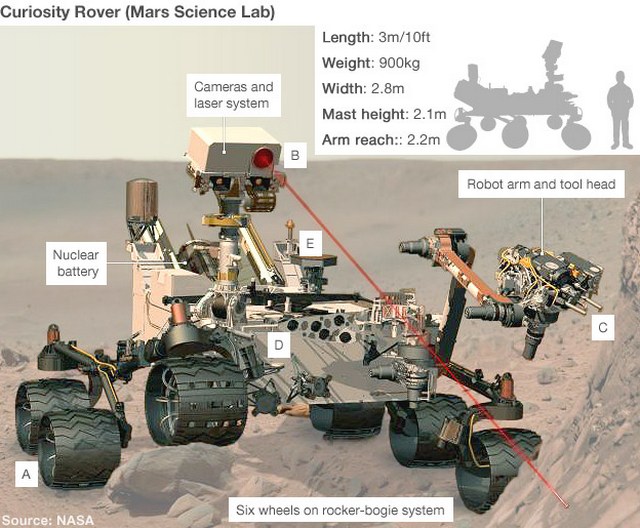

"Curiosity" rover on Mars
Washington -€” The Curiosity rover is moving across the surface of Mars, approaching its first target to conduct contact science, gathering and analyzing samples of materials. In the true tradition of NASA and the Jet Propulsion Laboratory managing the project, the ground team has named this target Jake Matijevic, honoring a scientist who made significant contributions to the design and engineering of a generation of planetary rovers. Matijevic died two weeks after this Mars Science Laboratory (MSL) touched down on the Red Planet in early August. MSL is also multitasking in its seventh week on the planet. At the same time the craft is preparing to gather data that will give scientists insight into the planet's geologic history, the craft's other instruments are looking to the Martian skies to track the movement of Mars' two moons, Deimos and Phobos. For the first time, humans are getting actual photos — by the hundreds — of these two satellites as they move across the Martian sky, according to Mark Lemmon of Texas A&M University, Curiosity's science team co-investigator. The photographic record that MSL transmits back to Earth will allow scientists to take very precise measurements of the orbital patterns of the two moons. They already know that the orbits are changing. "Very slowly over time, Phobos will eventually break up and fall into Mars," Lemmon said at an online press briefing from JPL headquarters in Pasadena, California. Just as our moon affects the tides on Earth, the Martian moons are also exerting gravitational influences on Mars "ever so slightly," said Lemmon. While MSL does not have the capability to drill far into the core of Mars, the measurements revealing the lunar influence on the planet will provide some insights into how the planet's core may be responding, and that may reveal more about the properties of the materials that form the core. Meantime, on the surface, the arms and the instruments of the rover are about to go to work investigating an object that project scientist John Grotzinger calls "a cool-looking rock." Now known as Jake Matijevic, the rock is 25 centimeters tall and 40 centimeters wide at the base, Grotzinger said, and it's one that has been detected previously by imaging equipment aboard the Mars orbiters because of its "high thermal inertia." That term describes the rock's capacity to retain heat, Grotzinger explained, even when the surface cools off overnight. The orbiters spotted the elevated temperature of this particular rock in contrast to the surface where it rests. This means the rock is made of a material that merits analysis by the sophisticated instruments aboard MSL. JPL engineer Jacob Matijevic was 64 when he died August 20. A 30-year veteran at JPL, he was still working on the latest Mars mission in early August as the MSL spacecraft approached the Red Planet on a journey that began in November 2011. Matijevic was the surface operations systems chief engineer for MSL and the Curiosity rover. He spent most of his career developing Curiosity's predecessors, which were the pioneer vehicles to serve as surrogates for scientists on Mars. Matijevic was "one of the original technology developers," according to Curiosity project manager Richard Cook, as NASA engineers first began to dream of sending remote vehicles to other planets. He was a leading engineer on all the rovers that NASA has sent to Mars over the decades, including Sojourner, Spirit and Opportunity. The Sojourner rover, flown to Mars in 1996, was the first to reveal the Martian history as a warm, wet planet. That rover weighed less than 11 kilograms; today's rover is the size of a compact car, a technological evolution to which Matijevic dedicated his life. "He was probably one of the top one or two surface operations experts here at JPL," Cook said at the September 19 briefing. In Martian-length days, September 19 was Sol 43 of the rover's mission, and the craft had traveled almost 300 meters from its landing site. Source iipdigital.usembassy.gov The Curiosity rover is moving across the surface of Mars, approaching its first target to conduct contact science, gathering and analyzing samples of materials. In the true tradition of NASA and the Jet Propulsion Laboratory managing the project, the ground team has named this target Jake Matijevic, honoring a scientist who made significant contributions to the design and engineering of a generation of planetary rovers. Late NASA engineer Jake Matijevic was of Croatian origin. Source: US Embassy in Croatia's capital Zagreb |

Opportunity Eyes Rock Fins on Cape York, Sol 3058
Rock fins up to about 1 foot (30 centimeters) tall dominate this scene from the panoramic camera (Pancam) on NASA's Mars Exploration Rover Opportunity.
Image Credit: NASA/JPL-Caltech/Cornell/Arizona State Univ.
| September 28, 2012 Mars Rover Opportunity Working At 'Matijevic Hill' PASADENA, Calif. - NASA's Mars rover Opportunity, well into its ninth year on Mars, will work for the next several weeks or months at a site with some of the mission's most intriguing geological features. The site, called "Matijevic Hill," overlooks 14-mile-wide (22-kilometer-wide) Endeavour Crater. Opportunity has begun investigating the site's concentration of small spherical objects reminiscent of, but different from, the iron-rich spheres nicknamed "blueberries" at the rover's landing site nearly 22 driving miles ago (35 kilometers). The small spheres at Matijevic Hill have different composition and internal structure. Opportunity's science team is evaluating a range of possibilities for how they formed. The spheres are up to about an eighth of an inch (3 millimeters) in diameter. The "blueberries" found earlier are concretions formed by the action of mineral-laden water inside rocks, but that is only one of the ways nature can make small, rounded particles. One working hypothesis, out of several, is that the new-found spherules are also concretions but with a different composition. Others include that they may be accretionary lapilli formed in volcanic ash eruptions, impact spherules formed in impact events, or devitrification spherules resulting from formation of crystals from formerly melted material. There are other possibilities, too. "Right now we have multiple working hypotheses, and each hypothesis makes certain predictions about things like what the spherules are made of and how they are distributed," said Opportunity's principal investigator, Steve Squyres, of Cornell University, Ithaca, N.Y. "Our job as we explore Matijevic Hill in the months ahead will be to make the observations that will let us test all the hypotheses carefully, and find the one that best fits the observations." The team chose to refer to this important site as Matijevic Hill in honor of Jacob Matijevic (1947-2012), who led the engineering team for the twin Mars Exploration Rovers Spirit and Opportunity for several years before and after their landings. He worked at NASA's Jet Propulsion Laboratory, Pasadena, Calif., from 1981 until his death last month, most recently as chief engineer for surface operations systems of NASA's third-generation Mars rover, Curiosity. In the 1990s, he led the engineering team for the first Mars rover, Sojourner. A different Mars rover team, operating Curiosity, has also named a feature for Matijevic: a rock that Curiosity recently investigated about halfway around the planet from Matijevic Hill. "We wouldn't have gotten to Matijevic Hill, eight-and-a-half years after Opportunity's landing, without Jake Matijevic," Squyres said. Opportunity's project manager, John Callas, of JPL, said, "If there is one person who represents the heart and soul of all three generations of Mars rovers -- Sojourner, Spirit and Opportunity, Curiosity -- it was Jake." JPL, a division of the California Institute of Technology in Pasadena, manages the Mars Exploration Rover Project for NASA's Science Mission Directorate in Washington. For more information about Opportunity, visit: http://www.nasa.gov/rovers and http://marsrovers.jpl.nasa.gov . You can follow the project on Twitter and on Facebook at: http://twitter.com/MarsRovers and http://www.facebook.com/mars.rovers . Guy Webster 818-354-6278 Jet Propulsion Laboratory, Pasadena, Calif. guy.webster@jpl.nasa.gov Source www.legacy.com |
Dr. Jacob Matijevic professional scientific articles published in the field of Mathematics Estes, Dennis R.; Matijevic, Jacob R.: Local-global criteria for outer product rings. Canad. J. Math. 32 (1980), no. 6, 1353-€“1360. Estes, Dennis R.; Matijevic, Jacob R.: Matrix factorizations, exterior powers, and complete intersections. J. Algebra 58 (1979), no. 1, 117-135. Estes, Dennis R.; Matijevic, Jacob R.: Unique factorization of matrices and Towber rings. J. Algebra 59 (1979), no. 2, 387-394. Anderson, D. D.; Matijevic, J. Graded: pi-rings. Canad. J. Math. 31 (1979), no. 3, 449-457. Johnson, Jon L.; Matijevic, Jacob R. Krull: dimension in graded rings. Comm. Algebra 5 (1977), no. 3, 319-329. Anderson, D. D.; Matijevic, J.; Nichols, W.: The Krull intersection theorem. II. Pacific J. Math. 66 (1976), no. 1, 15-22. Matijevic, Jacob R.: Maximal ideal transforms of Noetherian rings. Proc. Amer. Math. Soc. 54 (1976), 49-52. Matijevic, Jacob: Three local conditions on a graded ring. Trans. Amer. Math. Soc. 205 (1975), 275-€“284. Matijevic, Jacob; Roberts, Paul: A conjecture of Nagata on graded Cohen-Macaulay rings. J. Math. Kyoto Univ. 14 (1974), 125-128. Source American Mathematical Society, proceed to MathSciNet |
Alumni Awards 2015 Lifetime Achievement Award The Lifetime Achievement Award is bestowed posthumously on an individual who has recently passed away and who, during his or her life, achieved personal success, made an outstanding contribution to his or her chosen field of endeavor, and achieved recognition by his or her colleagues. Jacob R. Matijevic (MATH '€™69) Degrees: B.S. Mathematics ('€™69), Illinois Institute of Technology; M.S. ('70), Ph.D. ('€™73), Mathematics, The University of Chicago  Dr. Jacob Matijevic Career: Matijevic began his career as a mathematics professor, first at the University of Kentucky, then at the University of Southern California (USC). While at USC, he followed NASA'€™s Voyager missions and discoveries; he left USC in 1981 for work at NASA'€™s Jet Propulsion Laboratory (JPL), where he worked until the time of his death in August 2012. He was one of the original technology developers for the Mars rovers. He led the surface operations for the Sojourner rover in 1996 and worked up to more extensive Mars exploration missions, becoming rover engineering team chief for the twin rovers Spirit and Opportunity, which began exploring the planet in 2004. In 2012 the Curiosity rover, for which Matijevic was surface operations systems chief engineer, landed on Mars. Nomination: John Callas, project manager of the Mars Exploration Rover project, nominated Matijevic. "€śIf there is any one person that represents the heart and soul of these exquisite, complex, robotic systems, it is Jake," Callas says. "He was exceedingly knowledgeable while remaining very humble. It is his lifetime contributions that have allowed our species to explore the surface of another world." Honors and Awards: From his early contributions to mathematics - he developed the Matijevic Theorem, which has been called "€śone of the most beautiful results of recent years in commutative algebra" - €”to his more recent contributions to robotics and space exploration, Matijevic has acquired many accolades. He has more than 40 items on his publication list and has been honored by NASA and JPL multiple times. He was the recipient of the 1998 NASA Outstanding Leadership Medal, the 2006 NASA Honor Award Exceptional Achievement Medal, and the 2007 and 2008 JPL Mariner Bonus Award, in addition to many NASA group achievement awards and JPL team bonus awards. For his many contributions to the rover projects, NASA named two Mars landmarks in his honor: Matijevic Hill, investigated by Opportunity, is located on the western rim of the planet's Endurance Crater, and Jake Matijevic, encountered by Curiosity, is a pyramidal rock in Gale Crater. Source alumni.iit.edu |
| Ă‚Ă‚Â Jacob R. Matijevic, 1947-2012 Engineer worked on Mars rover missions October 10, 2012 | By Bob Goldsborough, Special to the Tribune Jacob R. Matijevic was trained as a mathematician and spent time as a math professor, but he found his greatest professional success as an engineer working on exploration projects that studied the climate and geology of Mars. "The Mars rovers that he worked on are very complex systems, and no one person can know the entirety of each one of these systems," said John Callas, the Jet Propulsion Laboratory's project manager for the Mars Exploration Rover. "He was the most knowledgeable person on the entirety of the system, so if you had a question, he was the guy to go to." Source articles.chicagotribune.com JACOB R. MATIJEVIC Obituary Jacob "Jake" Matijevic passed away in his home in Los Angeles, CA on Aug. 20, 2012, after a life-long battle with asthma and other upper respiratory ailments. He was born on Nov. 3, 1947, the first of four children to the late Jacob and Helen (Nastav) Matijevic, in Chicago, IL. He is survived by his mother and his sisters, Maryhelen of Chicago, Patricia of Loveland, CO; and brother, Paul (Judith Wolf) of Park Ridge, IL. After teaching mathematics at the University of Kentucky and the University of Southern California, Jake joined the Jet Propulsion Laboratory (JPL) in Pasadena in 1981. His latest assignment was Engineering Operations Chief Engineer on the Mars Science Lab ("Curiosity") project. Jake touched the lives of many at JPL, as a trusted mentor to many young members of the engineering teams and as an exceptional colleague to numerous peers and scientists. A memorial mass will be held on Saturday, Sept. 1, at noon at St. Cajetan Church, 2445 West 112th St., Chicago, IL 60655. Memorial gifts may be made to the Mount Carmel High School Educational Foundation, 6410 S. Dante Ave., Chicago, IL 60637. Published in Chicago Tribune on August 31, 2012 Guest Book in honour of late Dr. Jacob R. Matijevic October 26, 2012 Just Caricaturist and illustrator from the UK who's always looked to the stars. Thanks for helping me do that. October 16, 2012 Bog te blagoslovio. Ron Cindrich, Sunland, California October 15, 2012 My condolences to the friends and family. I went to high school w/ Jake at Mt. Carmel. I had not seen him since then, but I remember him as being so intelligent and a most decent young man. Mike Donaghue, College Park, Maryland October 12, 2012 Hi Never met you Jacob, thank you for helping us explore the stars frank bevan, telford, British Columbia October 08, 2012 As a colleague of Jake's at JPL, I was honored to work with him during the development phase of the MSL (Curiosity) mission. I learned a tremendous amount of technical info from his vast experience in robotic Mars mission development. He was very approachable and always willing to spend time to impart his knowledge to me. I will always be grateful for his contributions and I'll miss him very much. He is well deserving to have features on Mars named after him. Chuck Baker, Pasadena, California October 01, 2012 The latest tribute to Jake is that the Opportunity Rover team operating the 2003 rover has named a hill that they are exploring after Jake. He is now memorialized at two places on Mars. marsrovers.jpl.nasa.gov Donna Shirley September 28, 2012 May you, the people of America, continue your exploration and pursue the outer boundaries of the universe, in the same way that brave explorers have done on Earth and put this knowledge to the good of mankind, in the generous way that your country has done in the past. Mark Bailey, Kings Lynn September 25, 2012 It is sad that Jake had such a short life yet he did so much good with it. It is befitting that he name is borne on Mars. faroq khan, fort worth, Texas September 25, 2012 It's so sad to know that such a people are going in a such productive and important for all mankind age. I didn't know the guy, but I'm just so sad... Victor Geisherik, Rego Park, New York September 25, 2012 Rest in peace, new generations of scientists will continue your exceptional work in Mars September 22, 2012 My thoughts and prayers are with you in your time of grief. May your memories bring you comfort. MARY BARRUETA, WEST PALM BEACH, Florida September 21, 2012 Am an ardent follower of Martian missions, all the way from Africa.Rest in peace after having enabled humanity conquer the skies. Vitalis Mungayi, Nairobi September 21, 2012 I am so sorry you are gone. But I am so pleased that the Mars rock is named for you. What a great and deserving tribute. Linda Fahlberg-Stojanovska, Sarona, Wisconsin September 20, 2012 Just another great that has passed into the history books. Sad to hear he left so early September 20, 2012 I am so sorry for your loss. My thoughts are with you and your family. Alexis Dames, MIAMI, Florida September 20, 2012 Like Donna Shirley, I had the honor of working with Jake on the Pathfinder mission. He was always kind, patient, and understanding to this non-engineer, non-scientist. My sincere and deep condolences to the family. David Dubov, Washington, District of Columbia Contact Me September 20, 2012 To Jake's Family - I worked with him for several years when I managed the first Mars Rover, Sojourner Truth, and appointed him to replace me when I was promoted. Jake was a lovely person, very kind and hard working and he was a pleasure to work with. Even with all his health problems he did his job very well and never complained. I know you will miss him, but you should know what a great contribution he made to the exploration of Mars. Donna Shirley, Tulsa, Oklahoma September 20, 2012 Congratulations on all of your successes. Now is a time to reflect on your contributions to ground-breaking science. Thank you and rest in peace. Scott P, United Kingdom September 20, 2012 Offered a Plenary Indulgance for him at OMGC. Chuck September 19, 2012 I remember my cousin Jacob from when we were children. His career and achievements were well known by us and he was a tremendous source of pride to us all. His amazing accomplishments will never be forgotten. You have our deepest sympathy. Dick & Linda Nastav, Chicago, Illinois My sincere sympathies to the loss of your brother and son, Lisa Oppenheim September 02, 2012 Our sincerest sympathy on the recent passing of your brother Jacob. Sam & Eileen Salah, Palos Park, Illinois September 02, 2012 We were very sorry to hear of Jacob's passing. Our sincerest sympathy to the Matijevic Family. Dorothy and Ron Nastav, Arlington Heights, Illinois August 31, 2012 To Maryhelen and Family, Know of my prayerful support for you during these days. May Jacob rest in peace. Father Jim Lewis, Notre Dame, Indiana Source www.legacy.com |
Please, leave your message in the Guest Book in honour of late Dr. Jacob R. Matijevic. Thank you.
Formated for CROWN by Darko ®ubrinić
Distributed by www.Croatia.org . This message is intended for Croatian Associations/Institutions and their Friends in Croatia and in the World. The opinions/articles expressed on this list do not reflect personal opinions of the moderator. If the reader of this message is not the intended recipient, please delete or destroy all copies of this communication and please, let us know!